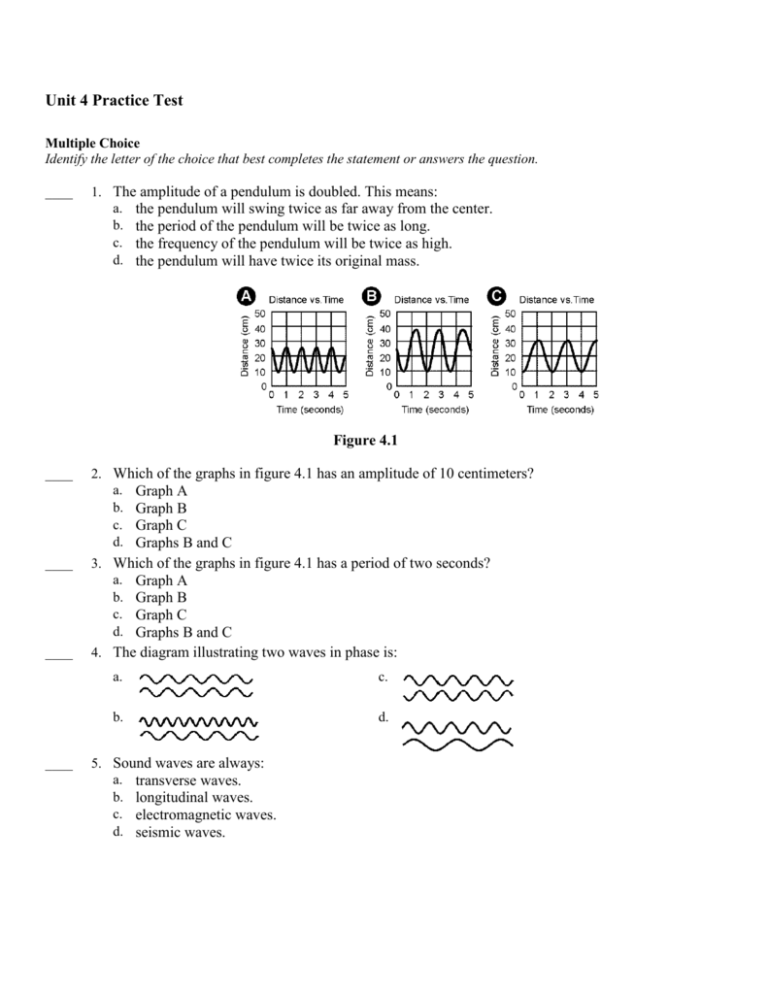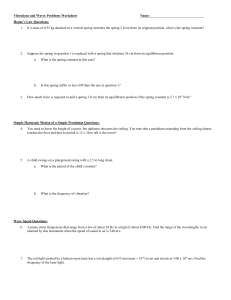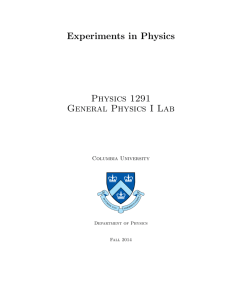Unit 4 Practice Test
advertisement

Unit 4 Practice Test Multiple Choice Identify the letter of the choice that best completes the statement or answers the question. ____ 1. The amplitude of a pendulum is doubled. This means: a. the pendulum will swing twice as far away from the center. b. the period of the pendulum will be twice as long. c. the frequency of the pendulum will be twice as high. d. the pendulum will have twice its original mass. Figure 4.1 ____ 2. Which of the graphs in figure 4.1 has an amplitude of 10 centimeters? a. Graph A b. Graph B c. Graph C d. Graphs B and C ____ 3. Which of the graphs in figure 4.1 has a period of two seconds? a. Graph A b. Graph B c. Graph C d. Graphs B and C ____ 4. The diagram illustrating two waves in phase is: ____ a. c. b. d. 5. Sound waves are always: a. transverse waves. b. longitudinal waves. c. electromagnetic waves. d. seismic waves. ____ 6. Which of the following usually occurs inside a material instead of at the surface? a. Reflection b. Refraction c. Diffraction d. Absorption ____ 7. Natural frequency is: a. what happens when two waves combine to produce one wave of lower amplitude. b. the frequency at which a system oscillates when it is disturbed. c. the rate at which vibrations are naturally damped in an oscillator. d. an oscillator whose frequency is a multiple of another wave. ____ 8. The picture below shows five harmonics of a vibrating string experiment. The vibrating string incorrectly labeled is: a. b. c. d. 1 2 3 4 ____ 9. A decibel is a unit used to measure the: a. pitch of sound. b. color or complexity of sound. c. loudness of sound. d. frequency of a sound. ____ 10. The musical scale consists of a set of frequencies divided into "octaves" represented by letters A to G. In the middle of the scale, middle C has a frequency of 264 hertz. The frequency of the "C" above middle C is: a. 132 hertz. b. 264 hertz. c. 272 hertz. d. 528 hertz. Matching Match the following terms with the correct definition. There is one extra term that will not match any of the definitions. a. cycle b. hertz c. amplitude d. period e. wavelength f. interference ____ ____ ____ ____ ____ 11. 12. 13. 14. 15. Time for one cycle to occur A single unit of periodic motion Distance from one point on a wave to the same point on the next wave Unit of measurement for frequency (one cycle per second) Happens when two or more waves interact Match the following terms with the correct definition. There is one extra term that will not match any of the definitions. a. resonance b. decibel c. system d. frequency e. oscillator f. harmonics ____ ____ ____ ____ ____ 16. 17. 18. 19. 20. Multiples of the fundamental A group chosen to include all those things of interest to be studied A system that shows harmonic motion The maximum response to an oscillating force occurring at a natural frequency Number of cycles that occur in one second Short Answer 21. How are frequency and period related? 22. Which graphs represent two pendulums that are in phase? Figure 4.1 23. What is the period of the pendulum whose motion is graphed in Figure 4.1? 24. What is the amplitude of the pendulum whose motion is graphed in Figure 4.1? 25. The pictures below represent vibrating guitar strings. Which picture shows a guitar string of one and only one wavelength? 26.Two pulses are traveling on the same rope as shown in the diagram. As they meet, what type of interaction will occur at their meeting point? Problem 27. The distance between the crests of two waves on a lake is 2.0 meters. The waves break on the shore every 5 seconds. How fast do the waves move on the surface of the water? 28. On a guitar, if the natural frequency of a 64 centimeter string is 140 hertz, what is the frequency of a 48 centimeter string? Essay 29. Describe each of the following wave interactions using at least one complete sentence. a. b. c. d. reflection refraction diffraction absorption 30. State THREE pieces of evidence that allow us to refer to sound as a wave. Unit 4 Practice Test Answer Section MULTIPLE CHOICE 1. 2. 3. 4. 5. 6. 7. 8. 9. 10. A C C A B D B B C D MATCHING 11. 12. 13. 14. 15. D A E B F 16. 17. 18. 19. 20. F C E A D SHORT ANSWER 21. 22. 23. 24. 25. 26. Frequency and period are inversely related. A and C 0.5 seconds 30 centimeters b destructive interference or They cancel each other out. PROBLEM 27. velocity = wavelength period velocity = 2.0 m 5 sec velocity = 0.4 m/sec 28. The string length is 1/2 of the wavelength of the sound produced. Since the velocity of the sound wave on the string is constant, the frequency can be calculated as follows: velocity = frequency wavelength velocity = 140 Hz 1.28 m velocity = 179 m/sec, the original velocity. frequency = velocity wavelength frequency = 179 m/sec 0.96 m frequency = 186 Hz ESSAY 29. a. Reflection occurs as a wave meets a boundary and bounces off, traveling in a new direction. b. Refraction occurs as a wave passes through a boundary. It may change wave direction. c. Diffraction occurs when a wave travels around an obstacle or through an opening in a boundary. Wave direction is usually changed. d. Absorption occurs as the amplitude of the wave decreases when the wave passes into and through a material. 30. Answers may vary. Correct answers include: Sound shows evidence of interference and diffraction. Sound can be reflected, refracted, and absorbed. Sound has a wavelength that can be demonstrated. Sound has a frequency that can be demonstrated. The speed of sound is frequency wavelength. Resonance can be demonstrated using sound.








